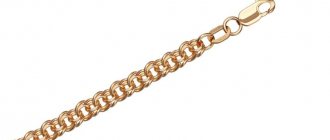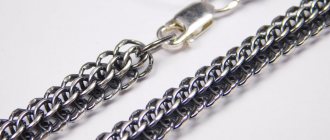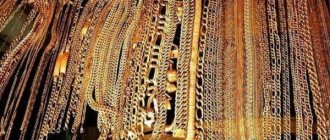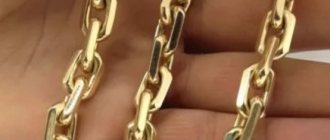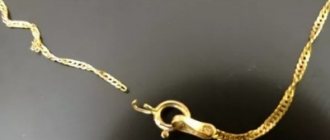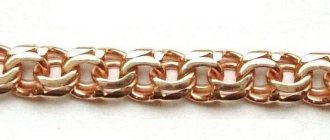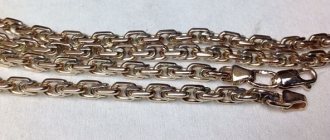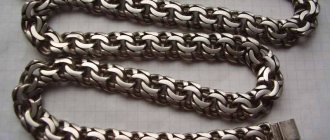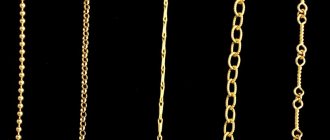Gold and silver chains are the most versatile jewelry. Chains are worn by men and women, regardless of age. Thin chains of the smallest sizes are also suitable for children. Chains can be an independent accessory, or they can be complemented by a pendant. You can wear one chain, or you can wear several at once, combining different metals, weaves and chain thicknesses.
The main characteristics of the circuits include:
- The precious metal from which the chain is made, its fineness;
- Chain thickness and weight;
- Weaving type.
Jewelry chains are made of 585 red, white or lemon gold, as well as 985 silver.
Gold chain weight
It would seem that the weight of a gold chain directly depends on its size. But it's not that simple. There is such a thing as full-weight and hollow chains. From the name you already guessed that hollow chains are made of links that are hollow inside. This allows you to get jewelry of impressive size, light weight and, accordingly, having a lower cost than a full-weight (solid) analogue.
Full weight chains have more weight and cost and are more resistant to damage.
Production of gold chains
According to the nature of their manufacture, chains are divided into the following types:
- machine knitting;
- manual;
- stamped.
In the first case, thin, light gold chains with small links are obtained. For their manufacture, ultra-thin gold wire is used, the diameter of which does not exceed 0.15 millimeters. The automatic link creation machine works so quickly that it produces 600 pieces in one minute. After the links are fastened together, the finished chain is calcined in a special oven. There, under the influence of high temperature, the ends of each link are soldered, which guarantees the strength of the product. If all technological processes are carried out without violating the rules, the machine-knitted chain will serve its owner for many years.
In terms of quality and reliability, machine-made gold chains cannot be compared with hand-knitted products.
The beauty of the finished jewelry and its durability depend on the skill of the jeweler. The manual method of creating products is often resorted to in small private workshops. They are also used in large enterprises, since truly exclusive products are created only by hand. When knitting by hand, you can create chains weighing up to 6 grams.
Stamped chains are produced using special dies. The shapes of individual links are pressed into gold sheet metal using stamps. Moreover, the thickness of the gold sheet does not exceed 0.3 millimeters. This type of production is less expensive and faster, and stamped chains look more voluminous, although their weight remains light. But in strength and durability they are inferior to machine-knitted and hand-knitted chains.
Making gold wire for chains
Craftsmen created exquisite jewelry from these thin twigs back in Ancient Egypt. Modern technologies make it possible to produce wire up to 3 kilometers long from one gram of pure gold. Surprisingly, ancient jewelers also possessed similar skills, although they did not have our high-precision units. During archaeological excavations in Egyptian Abydos, experts found gold jewelry made of wire, the diameter of which was equal to the thickness of a human hair - no more than a third of a millimeter!
Making twigs for knitting chains is a very painstaking work that requires attentiveness from the master. First, molten gold is poured into a mold (mold for ingots), producing a wire half a centimeter in diameter. It is stretched by passing it through several holes, the diameter of which gradually decreases.
The thickness of the finished wire varies from 0.2 to 2 millimeters.
The choice of thickness depends on what kind of jewelry the master plans to create from it: a chain, bracelet or earring loop. The expected weight of the future decoration is also taken into account - for weightless feminine ones you need the thinnest wire, and for masculine ones thicker.
When the master has received a twig of the required diameter, the formation of the links of the future chain begins. The gold thread is wound onto a special base and then removed from it to form a spiral. Then, using scissors, rings of the same diameter are cut.
Next, the craftsman manually fastens these links, taking into account the chosen type of weaving, and solders each one with solder so that they hold tightly. After this, the chain is clamped in special shafts and the links are made flat. The next stage is installing the lock and polishing the decoration.
Anchor chain weaving
The simplest chain weaving, the basic version, is when single oval links are connected at right angles to each other. The chain has a three-dimensional shape, and the larger the links, the greater the volume.
Changing the shape of the links to round or some other gives a new weave. For example, “Rollo” are round links, “Belzer” are flat oval links.
If we use double oval links rather than single ones, we get “Double Anchor” weaving. Double round links form a Garibaldi weave.
Armor chain weaving
Unlike anchor weaving, armor weaving is formed by connecting links in one plane, ensuring a tight fit of the decoration to the body. Chains with armor weave can be completely different in size and weight, but are equally comfortable to wear, flexible and durable.
Armor weaving also has a lot of varieties:
- Weaving "Nonna"
, which is popular among the fair half of humanity, is formed by links of different sizes. In this case, the smaller link ends up inside the larger one.
- Weaving "Rombo"
formed by links made in the shape of a rhombus. This type of weaving can be double or triple.
- Figaro weaving
differs in that links of different lengths alternate - three shorter links, then one long one.
- Weaving "Love"
— the chain links look like hearts, it looks very cute.
- Snake weave
— the links fit so tightly to each other that it seems like you have a smooth lace in front of you. This weaving looks beautiful not only in chains, but also in bracelets. “Snake”, in turn, can be flat or square, that is, form two more new types of weaving.
- Weaving "Singapore"
forms an openwork twisted chain, which makes it very elegant even without a pendant.
Types and reliability of jewelry locks
Even if you choose the thickest chain with the strongest weave, it can be easily lost - due to poor quality or unreliability of the lock.
- Carabiner lock. Outwardly it looks like a loop. Reliable, easy to use, repairable. Before buying jewelry, check how it works - it should click. If the clasp does not work well, you will need the help of a jeweler - you can change the spring inside.
Important: if the chain was subjected to sudden jerks during wear, then too large a gap could form between the loop and the moving part of the lock. If the chain is pulled sharply, carefully inspect the lock, because the connecting ring can slip into such a gap and then the chain can easily be lost.
- Spring lock. Round lock with spring latch. A simple option, which is used for products weighing up to 5 grams - it is not designed for heavier jewelry. Sometimes the springs break, then the fastener will need to be replaced. Pay attention to the ring that connects the lock to the chain - it must be sealed. Unsealed rings tear when worn.
- Box lock. Wear-resistant, strong, durable. Installed on massive chains. It can stretch over time, since silver and gold are soft metals.
- Screw lock. It looks neat, is easy to use, but is not very reliable - it can come loose in the most unexpected situations.
A good lock should be strong and not cause discomfort when opening and closing. If you are unsuccessfully trying to open a lock on a chain you like for the fifth time, it is better to ask the seller to show you another product.
Bismarck weave
Of course, it leads the list of popularity all over the world. Powerful, strong weave, which is preferred by men. But at the same time, it is plastic and effective, which women like. The unique strength of Bismarck weave is due to the fact that it is formed by links, which in turn also have components - multidirectional rings.
One of the subtypes of the beautiful and super-strong Bismarck weave is “Python” - a wide 3-row weave, which involves one central link and two side ones. A chain with such weaving is worn as an independent accessory; it is so self-sufficient that the pendants are lost against its background.
- "Arab Bismarck"
consists of links reminiscent of Arabic script and woven in two or more rows.
- "Moscow Bismarck"
- very smooth weaving due to the fact that the ends of the links are securely soldered.
- "Stream"
— the chain links resemble the bends of a stream. They seem to flow into each other and create the illusion of movement.
- "Cardinal"
- dense three-dimensional weaving of several rows of links intertwined with each other.
Which chain weave is the strongest?
Now that you have learned the different types of chain weaving, the question arises, which weave is the strongest and most reliable?
- It is worth noting that the simpler the shape of the links, the more reliable the chain. Even if damaged, it will be easier to repair. Ornate links of complex shape are often less durable and require careful wearing.
- In terms of strength, the leaders are the “Bismarck” and “Nonna” weaves, which have links of a simple shape, securely fastened together.
- The strength of the weaving is information that should be taken into account in order to treat your jewelry correctly, and when choosing a chain, still be guided by your own taste and the attractiveness of the product specifically for you.
Graduation of gold chains by strength and reliability
Even among jewelry with light weight and thick links, you can choose several durable options that are good for daily wear. For example, women can purchase a chain created by weaving a spikelet. Such products are strong and do not get tangled. Venetian weaving is also durable and easy to repair, like all other “anchor” weavings. In the event of a breakdown, a specialist will be able to easily replace or solder the broken element. These chains hold the weight of pendants or pendants well. But you need to take into account that Venetian weaving looks best if the links are small, massive options look rough.
Of the more massive types of knitting, “Figaro” is distinguished by its durability, which is often chosen by men. In general, all armored chains are durable and easy to repair. But it is important to check with sellers how the decoration was made. If you plan to purchase a stamped chain, be prepared to regularly remove it at night. Such models are at risk of deformation, and they are not easy to repair.
You need to be careful with snake weaving, since its individual fragments often get tangled together. Sometimes the links can become so twisted that the jewelry cannot even be repaired. Therefore, you need to wear them carefully and ensure the safety of the elements.
Remember: the simpler the design of a gold chain, the greater the chance of repairing it if necessary, and the less it will cost you.
DIY jewelry repair
If your chain breaks, it is best to immediately take it to a jewelry workshop, since it will be difficult to correct the situation with your own hands. But if you or someone in your family is familiar with a soldering iron and other tools that require precision, you can try to fix the problem yourself. The easiest way to deal with a defect in a chain connected with an anchor type of weaving. To restore a damaged link you will need the following set of tools and materials:
- an old gold chain or other deformed gold item;
- miniature vice;
- gas-burner;
- round nose pliers;
- blowpipe;
- asbestos sheet;
- sewing needle;
- needle file (small file with a fine notch).
For high-quality work, a small jewelry vice is important that will securely hold the product.
Clamp the torn section of the chain in a vice, and connect the links of the two torn ends with a needle - just push it through them. Place the vice on an asbestos sheet, which will prevent fire during further manipulations. If you are dealing with a massive gold chain that holds its shape well, then you can not fix it in a vice, but simply put it on asbestos. But in this case, secure the links with a needle. Heat the rupture site with a gas torch. Direct the flame to this point using a blowpipe.
As soon as the metal turns white, place a small piece of gold on the heated section of the chain, which will be enough for soldering. You need to wait until it completely melts, spreading over the deformed area of the product. Allow the gold to cool and harden. After this, use small wire cutters to remove the excess amount of gold solder and process the solder with a file. If you did everything correctly, the links will be sealed. In a similar way, you can, if necessary, reduce the length of the product. Only for this you will first need to unfasten the required number of links.
Gold chains are basic jewelry for men and women. Depending on the type of weaving, they can be an everyday accessory or a luxurious accent to an evening outfit. When choosing this jewelry, you need to focus not only on its beauty, but also on convenience, strength and durability.
Consider in advance whether an ornate interlocking chain would suit you for everyday wear. Keep in mind that if it breaks, repairing it can cost a lot of money.
